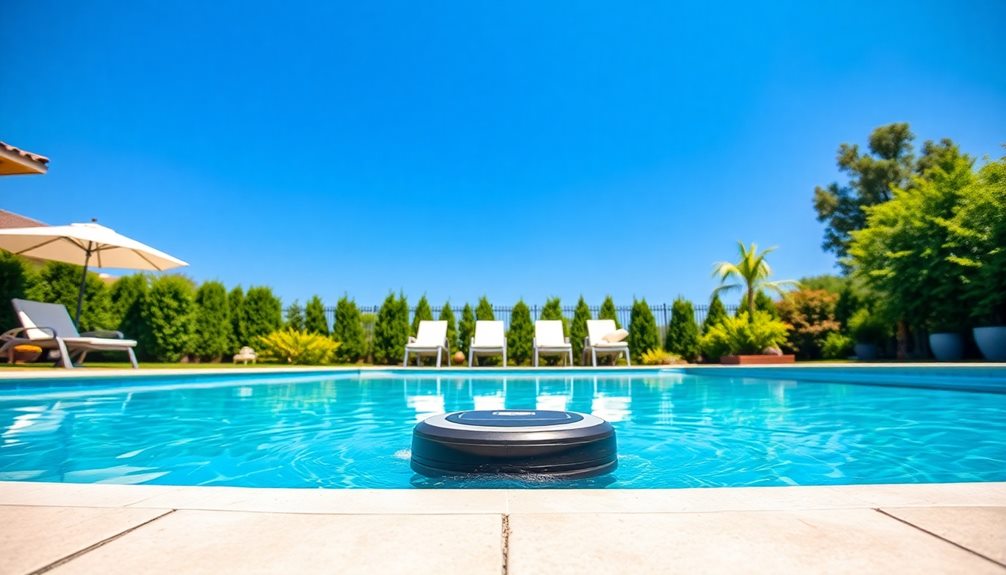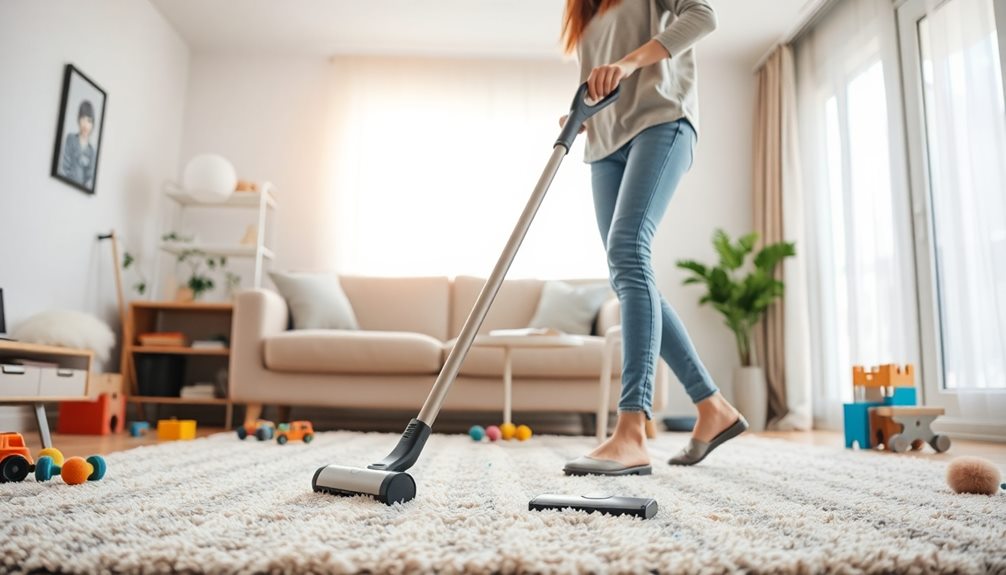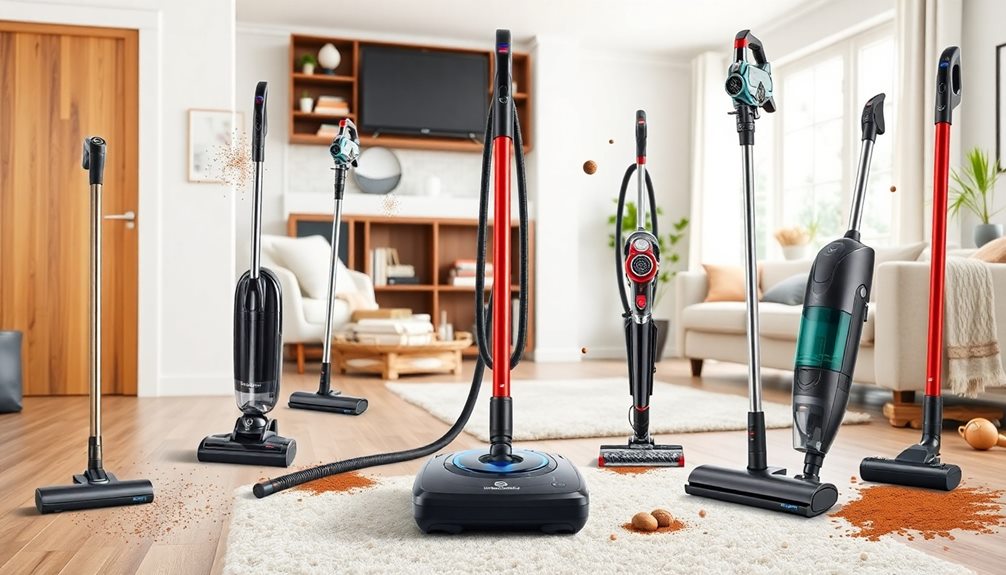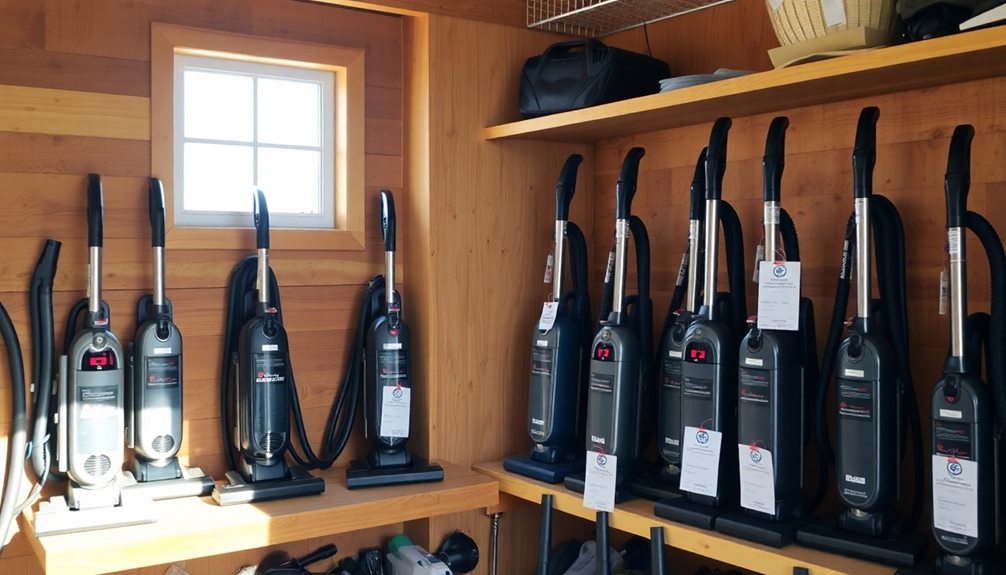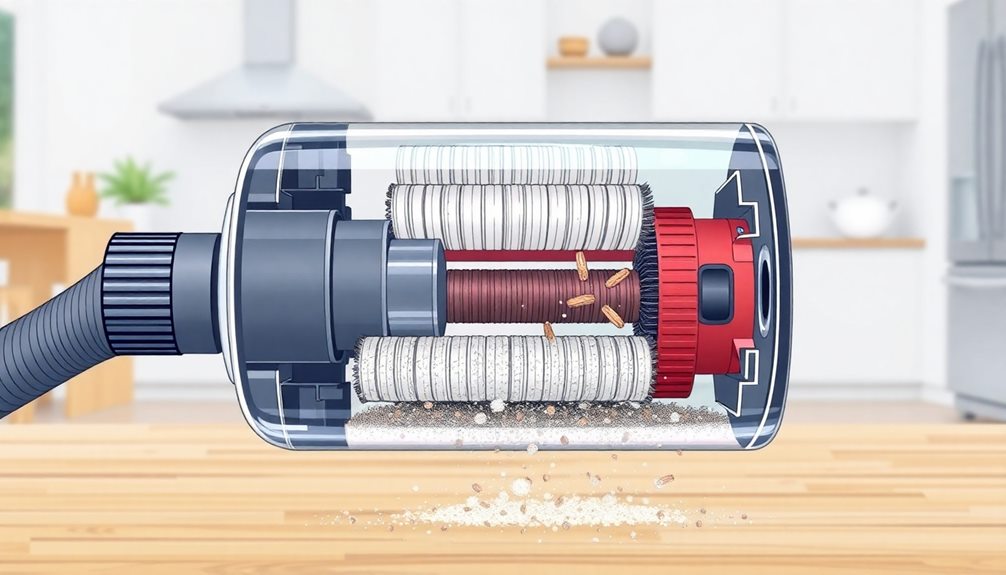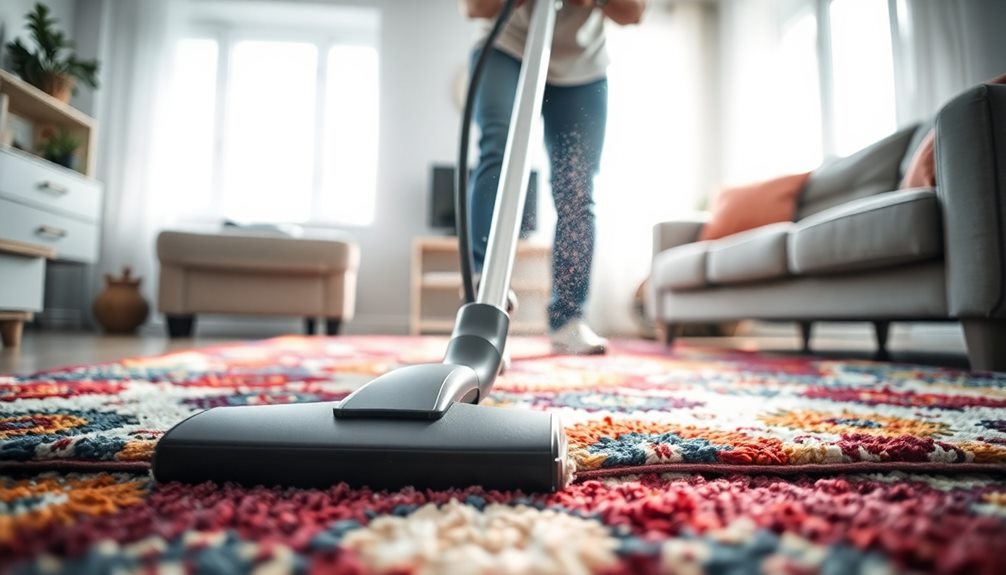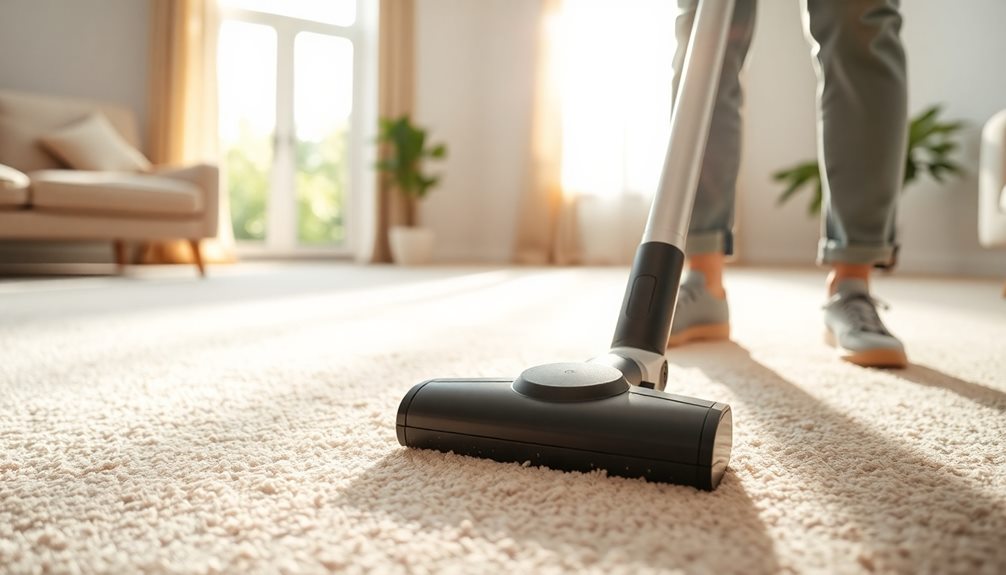To use a swimming pool vacuum cleaner, start by choosing the right type for your pool size and shape. Prepare your pool by removing visible debris, ensuring the pump works, and confirming the water level is adequate. Set up the equipment by connecting the vacuum head and hose securely. For in-ground pools, vacuum from the shallow end in a grid pattern. For above-ground pools, use straight lines and overlapping strokes. After vacuuming, inspect and clean all components to maintain performance. There's plenty more to discover about maintaining your pool and enhancing your vacuuming skills.
Key Takeaways
- Choose the right vacuum based on your pool size, shape, and cleaning preferences, considering manual or robotic options.
- Prepare your pool by clearing debris, ensuring the pump is operational, and verifying the water level is adequate for vacuuming.
- Check all equipment components for functionality, ensuring secure connections and inspecting hoses for leaks to maintain suction power.
- Follow proper vacuuming techniques, starting from the shallow end, using straight lines, and monitoring pressure levels throughout the process.
- Perform post-vacuuming maintenance by clearing debris from the pump strainer, rinsing equipment, and switching the filter valve back to normal settings.
Choose the Right Vacuum

When it comes to keeping your pool clean, choosing the right vacuum is essential. You need to take into account your pool size and shape. For targeted cleaning, a manual pool vacuum works well, but if you prefer a hands-free experience, robotic pool cleaners are a great option.
For example, the Dolphin E10 suits above-ground pools up to 30 feet, while the Dolphin Robotic Cleaner accommodates pools up to 50 feet.
Next, evaluate the cleaning method. Suction-side cleaners, like the Pentair Kreepy Krauly E-Z Vac, depend on your pool pump, whereas pressure-side cleaners, such as the Polaris Vac-Sweep 360, utilize water pressure from the return line.
This choice impacts your pool maintenance routine and overall efficiency.
Don't forget about maintenance requirements. Robotic vacuums usually need less frequent manual intervention but may require you to empty their built-in filter bags when full.
Finally, take into account your budget. Manual vacuums are generally more cost-effective upfront, but robotic cleaners can save you time and effort in the long run.
Balancing these factors will help you choose the right vacuum for your pool cleaning needs.
Prepare Your Pool
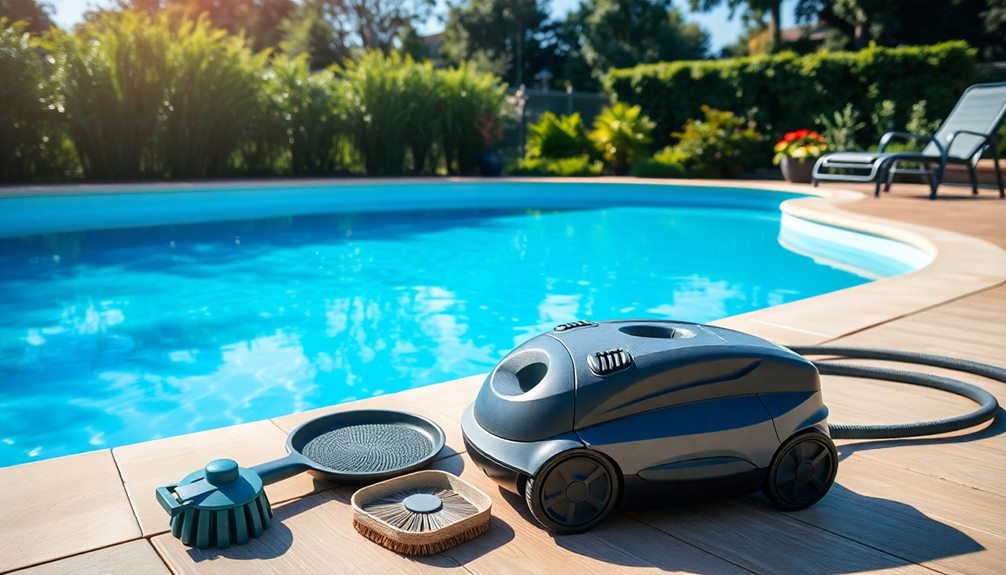
Before you start vacuuming, clear any visible debris from the pool surface with a skimmer or leaf rake to make your job easier.
Make sure your pool pump is working properly since it's essential for keeping the water circulating during the process.
Checking your equipment now will help guarantee you get the best results when you begin vacuuming.
Remove Surface Debris
Removing surface debris is an important first step in preparing your pool for vacuuming. Start by using a skimmer net or leaf rake to remove floating debris from the pool surface. This'll help prevent larger particles from clogging the vacuum head later on.
Additionally, consider using a reliable pool vacuum robot for a more efficient cleaning process. Next, you should clean out the skimmer basket; this action is essential to guarantee proper water flow during the vacuuming process.
Before you proceed, make certain the pool pump is turned on. This facilitates circulation and suction, making the debris removal more effective. It's also important to check the water level of your pool; it should be at the midpoint of the skimmer for maximum vacuuming performance. If the water level is too low, you may not achieve the best results.
After removing surface debris and confirming everything is in order, you can move on to using your vacuum equipment. Inspect your vacuum setup to confirm it's properly assembled and ready for action.
Check Equipment Functionality
Guaranteeing your equipment's functionality is essential for an effective pool cleaning session. Start by checking that all components, like the vacuum head, telescopic pole, and vacuum hose, are securely assembled and free from damage. Next, inspect your pool pump and filter; they should be operational, with the starting pressure within the recommended range to maintain ideal suction power.
Clean out the skimmer basket and pump strainer to prevent clogs that could hinder water flow. If you're dealing with heavy debris, adjust the filter valve settings to 'waste' to avoid clogging the filter. Also, inspect the vacuum hose for any leaks or cracks, as a damaged hose can greatly reduce suction power.
Here's a quick checklist to help you:
| Equipment | Importance | Action Required |
|---|---|---|
| Vacuum Head | Essential for cleaning | Check for damage |
| Pump and Filter | Guarantees ideal suction | Verify operational status |
| Skimmer Basket | Prevents clogs | Clean thoroughly |
Equipment Setup
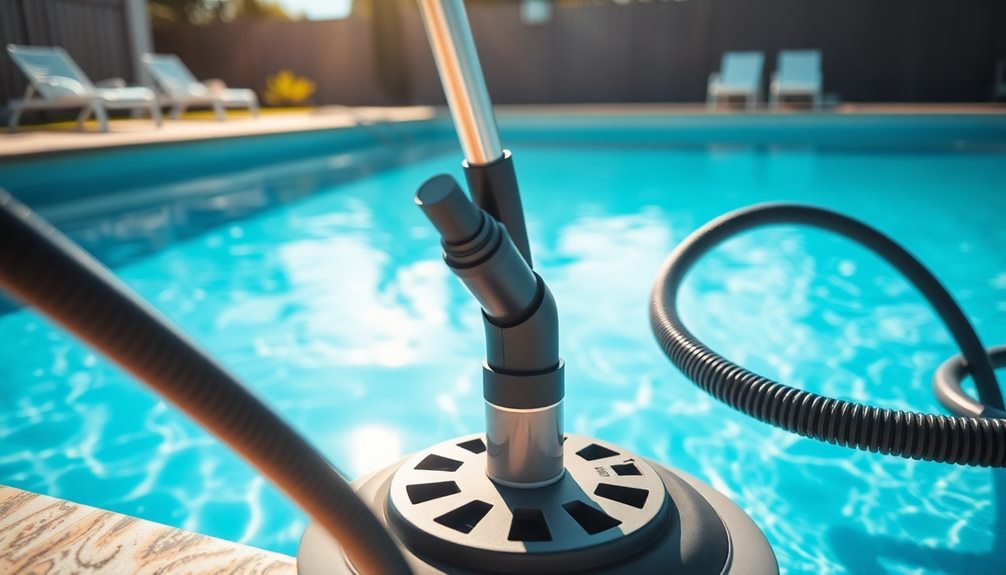
Proper setup of your swimming pool vacuum equipment is essential for effective cleaning. Start by assembling your vacuum system to guarantee everything works smoothly. Follow these steps for proper equipment setup:
1. Connect the Components: Secure the vacuum head to the telescopic pole and attach the long vacuum hose to the vac head. If you're using a manual vacuum, fill the vacuum hose by submerging the vacuum head in the pool and using the return jet to eliminate any air pockets.
2. Prepare the Pump: Confirm that the vacuum inlet is the only line open to the pool pump. This prevents dirt and debris from being unintentionally sucked into the system.
Check the pool pump and filter for proper operation, and set the filter valve to "Filter" or "Waste" based on your cleaning needs.
3. Secure the Hose: If the hose feels slippery, use a hose clamp to secure the connection between the hose and the vacuum head. This prevents disconnection during use and guarantees maximum suction.
With everything set up, you're ready for effective vacuuming!
Vacuuming an In-Ground Pool
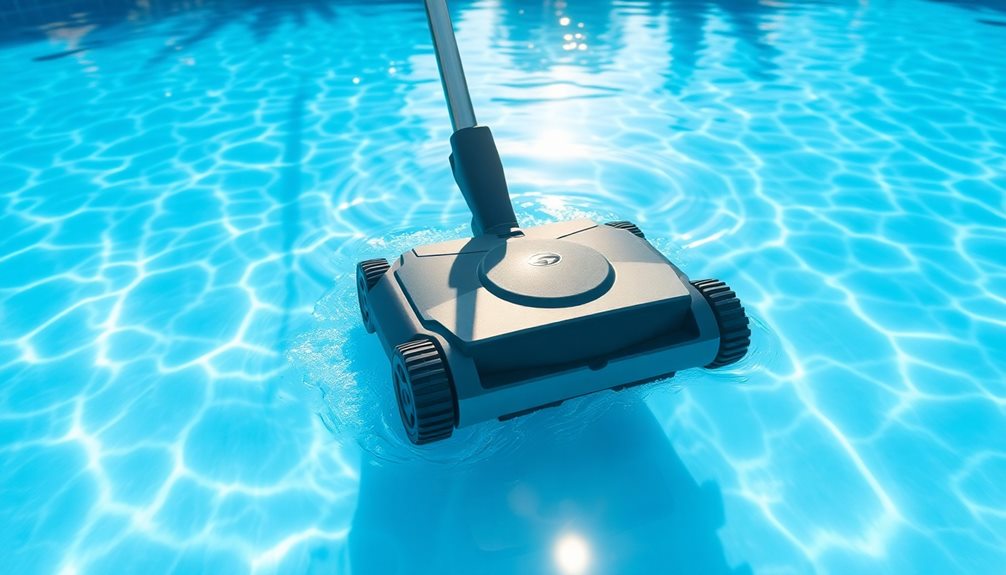
Vacuuming an in-ground pool can seem intimidating, but with the right approach, it's quite straightforward.
Start by ensuring that the pool water level is adequate and turn on the pump to facilitate water circulation. Choose a vacuum head that matches your pool's size and shape, then securely attach it to a telescopic pole.
Next, fill the vacuum hose with water to eliminate air pockets, then connect it to the vacuum head. Insert the hose into the skimmer plate for suction.
Begin the vacuuming process from the shallow end, moving towards the deep end. Use a grid pattern and slow, overlapping strokes to make sure you cover the entire pool and remove any dirt or debris effectively.
After vacuuming, keep an eye on the pressure gauge. If it exceeds the recommended levels, it's time to backwash the filter to maintain its efficiency.
This simple method will help you keep your in-ground pool clean and inviting, making your swimming experience much more enjoyable. Happy vacuuming!
Vacuuming an Above-Ground Pool
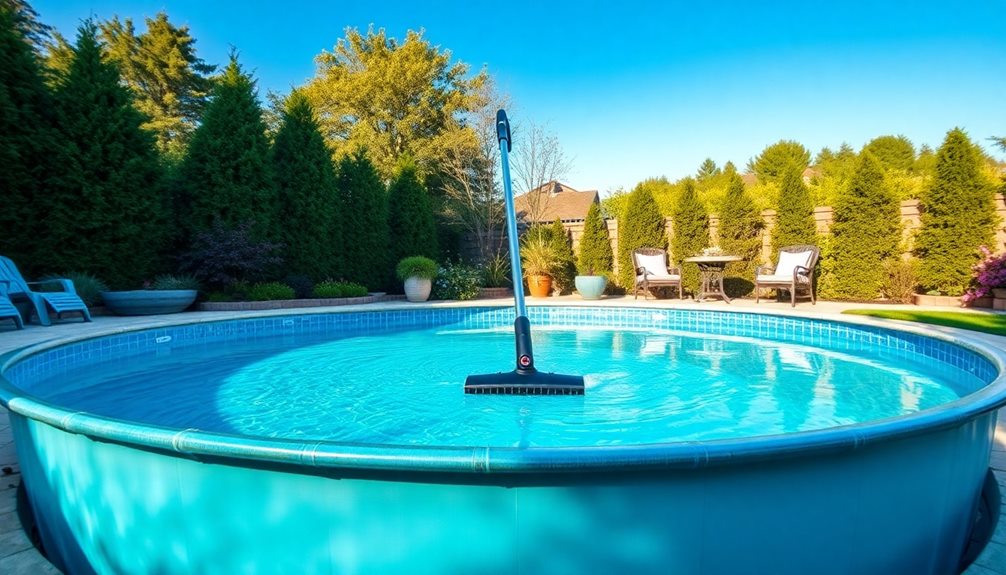
When you're ready to vacuum your above-ground pool, start by gathering the right equipment designed for its unique size and shape.
You'll want to follow specific techniques to guarantee a thorough clean, and don't forget about maintenance afterward to keep your pool sparkling.
Let's explore the setup process, effective vacuuming methods, and essential tips for post-cleaning care.
Equipment Setup Process
How do you guarantee your above-ground pool is cleaned efficiently? It starts with the proper setup of your pool vacuum. Follow these steps for an effective cleaning process:
- Select the Right Equipment: Choose a vacuum designed specifically for above-ground pools, guaranteeing it fits your pool's size and shape.
- Prepare the Vacuum: Lower the vacuum head into the pool until it touches the bottom. This guarantees it's fully submerged and ready for ideal cleaning.
- Fill the Hose: To eliminate air pockets, submerge the vacuum head in the water and allow the water to flow through the vacuum hose. Once filled, connect the hose to the skimmer plate tightly for effective suction.
With your equipment set, you can start the vacuuming process. Move the vacuum head in straight lines across the pool floor, overlapping strokes to capture all debris effectively.
As a pool owner, this method guarantees you get the most out of your pool vacuum, keeping your above-ground pool pristine and inviting.
Happy cleaning!
Vacuuming Techniques Overview
To guarantee your above-ground pool remains spotless, mastering effective vacuuming techniques is vital.
Start your vacuuming session by lowering the vacuum head until it makes contact with the pool floor. Make certain it's fully submerged to guarantee effective debris collection.
Next, fill the vacuum hose with water to eliminate any air pockets; this step is essential for maintaining strong suction once you connect to the skimmer plate.
Insert the hose securely into the skimmer plate to initiate the vacuuming process.
During your cleaning, move the vacuum head in straight lines across the pool floor. This systematic approach helps you cover the entire surface area and effectively remove dirt.
Regularly check for suction loss while you work. If you notice a drop in suction, adjust the hose or the water level as needed to maintain consistent cleaning performance.
Post-Vacuuming Maintenance Tips
After you've finished vacuuming your above-ground pool, it's important to take a few steps to guarantee everything stays in prime condition. Proper post-vacuuming maintenance will help prevent mildew and prolong the lifespan of your equipment.
- Disconnect and Drain: Immediately disconnect the vacuum head from the pole and drain any remaining water from the hose. This helps prevent mildew and wear on your equipment.
- Clean the Pool: Use a cleaning brush to scrub the sides of your pool, making sure you remove any debris that may have settled during the vacuuming process.
- Inspect Equipment: Check the pump strainer basket and clear out any collected debris to guarantee peak water flow and filter efficiency. If you used the waste setting on the filter valve, be sure to switch it back to the normal filter setting afterward.
Lastly, rinse all vacuuming equipment with clean water after use and store it in a shaded area. This protects your tools from harsh sunlight, helping to prolong their lifespan.
Vacuuming With a Sand Filter
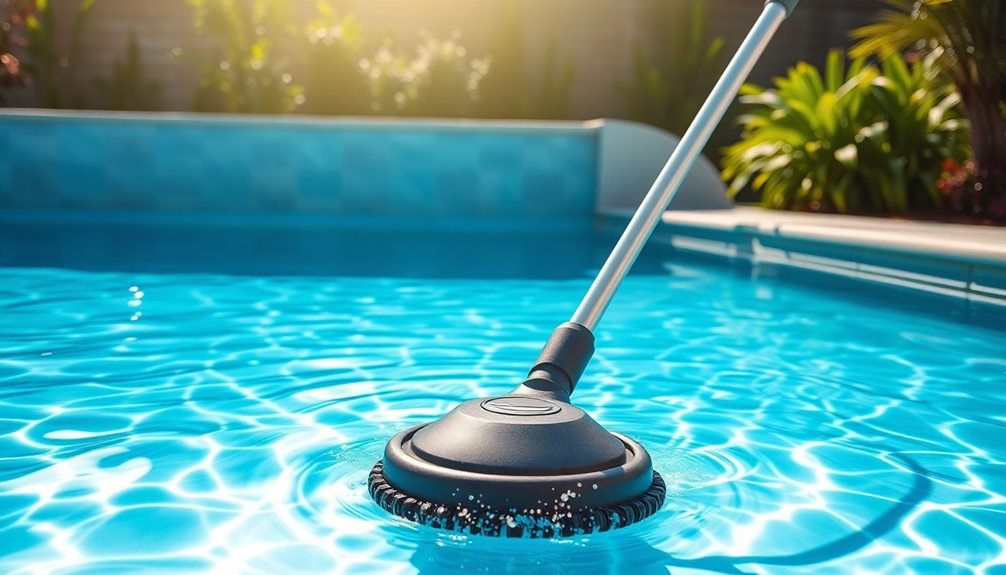
Effective pool maintenance requires a strategic approach, especially when vacuuming with a sand filter. Start by evaluating the pool debris and adjusting the filter valve to the "Waste" setting. This prevents clogging the sand filter with dirt and debris.
Next, connect the vacuum hose to the skimmer disk, ensuring a secure fit to maintain ideal suction during the process.
With the vacuum head and hose ready, move the vacuum cleaner steadily along the pool floor, covering all areas to effectively transfer pool debris to the pump. Throughout this process, keep an eye on the pressure gauge on the filter. If the pressure exceeds recommended levels, it's essential to backwash the filter to maintain efficiency and water clarity.
After you've vacuumed the entire pool, remember to backwash the sand filter. This step removes accumulated debris, ensuring your filter continues to operate effectively.
Regularly monitoring the pressure gauge during vacuuming can help you maintain a clean and clear pool, making your swimming experience more enjoyable. By following these steps, you'll keep your pool sparkling clean and well-maintained.
Post-Vacuuming Cleanup
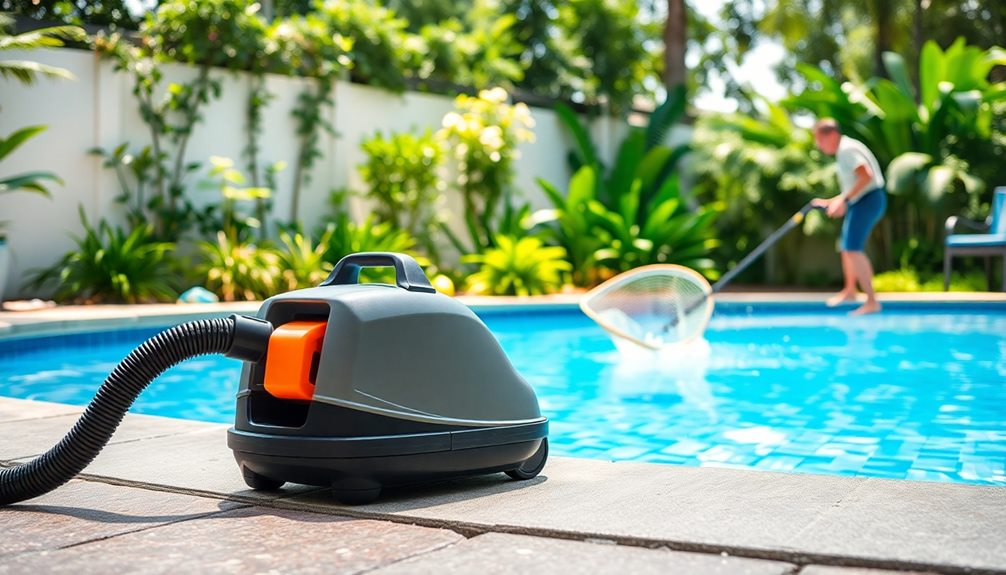
Completing the vacuuming process is just the beginning of guaranteeing your pool stays pristine. After you're done, it's essential to perform a thorough post-vacuuming cleanup to maintain the equipment and your pool's health. Here's what you need to do:
- Remove the vacuum head from the telescopic pole and drain any remaining water from the vacuum hose to prevent buildup.
- Use a cleaning brush attached to the pole to scrub the sides of the pool, guaranteeing all debris is removed from the surfaces.
- Clear the pump strainer basket of any debris collected during vacuuming. This helps maintain ideal water flow and filtration efficiency.
Also, if you'd the filter set to "Waste" during vacuuming, don't forget to switch the filter valve back to the "Filter" setting to resume normal operation.
Finally, rinse and dry all your vacuuming equipment before storing it away. This step is essential to prevent wear, corrosion, and the accumulation of dirt.
Maintenance Tips
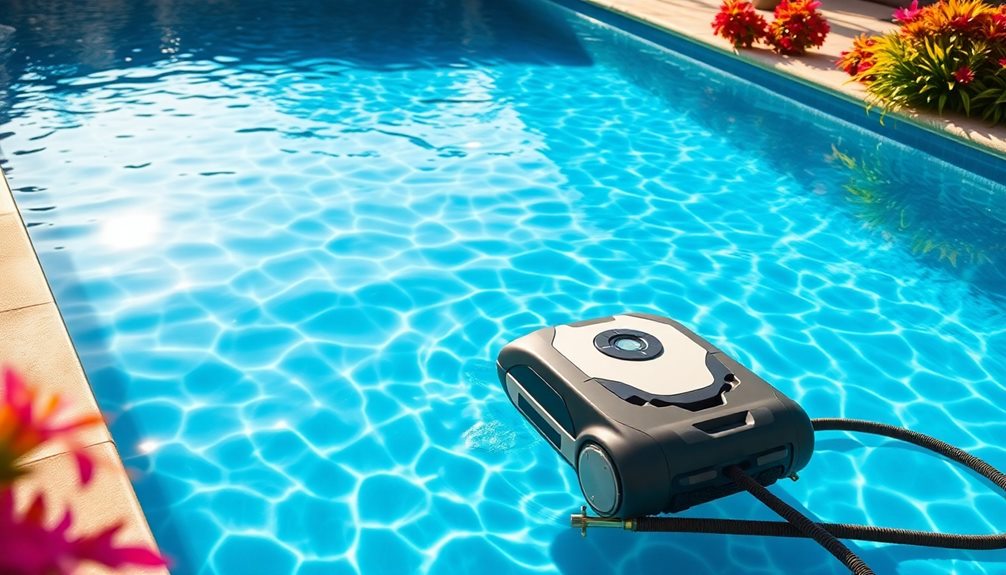
Regular maintenance is vital for keeping your swimming pool vacuum cleaner in top shape. Start by rinsing the vacuum head and hose with clean water after each use. This simple step removes debris and prevents buildup, guaranteeing peak performance during future cleaning sessions.
Next, inspect hoses regularly for leaks or cracks; even minor damages can greatly reduce suction power and efficiency.
Don't forget to clean the filter bags or cartridges according to the manufacturer's guidelines. Clogged filters can impede water flow, decreasing your vacuum's cleaning effectiveness. If you notice any worn or damaged parts, replace them promptly. Maintaining all components in good condition is essential for the longevity and efficiency of your pool vacuum system.
When you're done using the vacuum, store the equipment in a shaded area. This helps protect it from UV rays and harsh weather, which can lead to wear and corrosion over time.
Explore Automatic Cleaners
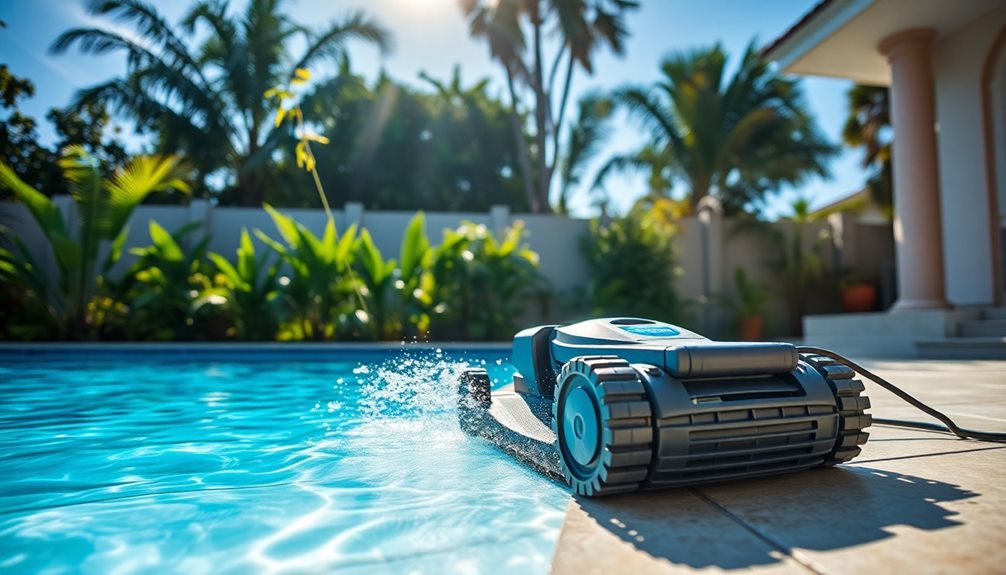
When it comes to keeping your pool clean with minimal effort, automatic pool cleaners are a game changer. These devices, including robotic cleaners and pressure-side cleaners, operate independently, allowing you to enjoy your pool without the hassle of manual cleaning.
Additionally, just like home security systems that offer various features and pricing options, automatic pool cleaners come in different models and price ranges to suit your needs. Here's why you should consider them:
- Efficiency: Robotic cleaners, like the Dolphin E10 and Dolphin Robotic Cleaner, can clean pools up to 30 and 50 feet in just a few hours, saving you valuable time.
- Filtration Systems: Most automatic pool vacuums come with built-in filtration systems, enhancing pool hygiene and reducing the need for manual skimming.
- Debris Collection: Pressure-side cleaners, such as the Polaris Vac-Sweep 65 and 360, utilize water pressure for effective debris collection, improving water circulation in both above-ground and in-ground pools.
While the initial investment in these cleaners can be higher, they ultimately save you time and labor costs, making them a smart choice for pool maintenance.
With automatic cleaners, you can maintain clean pools effortlessly, ensuring your swimming experience is always enjoyable.
Frequently Asked Questions
How Do You Vacuum a Pool for Beginners?
To vacuum a pool as a beginner, start by skimming debris, then set up your vacuum properly. Lower the vacuum head, fill the hose with water, and vacuum in a systematic pattern from shallow to deep.
What Setting Should the Pool Filter Be on When Vacuuming?
When vacuuming, set your sand or D.E. filter to "Waste" to expel debris directly. If you're using a cartridge filter, keep it on "Filter." Always revert to "Filter" after you're done vacuuming.
Do You Leave the Pump on When Vacuuming a Pool?
Yes, you should leave the pump on while vacuuming. This creates suction, allowing the vacuum to effectively collect debris. Just verify the pump's operational and watch the pressure gauge for peak performance during the process.
How to Hook up a Swimming Pool Vacuum?
To hook up a swimming pool vacuum, you'll need to attach the vacuum head to a pole, connect the hose to the head, fill it with water, and then insert the hose into the skimmer.
Conclusion
In the grand dance of pool maintenance, vacuuming is your trusty partner. By choosing the right vacuum and prepping your pool, you'll glide through the process with ease. Whether you're sweeping the depths of an in-ground oasis or a charming above-ground retreat, your efforts will guarantee crystal-clear waters await. So, embrace the rhythm of cleaning, and your pool will reward you with delightful splashes and joyful moments all season long. Plunge in and enjoy the sparkle!
